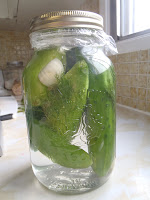 Cucumbers
CucumbersI come from a land of "refrigerator pickles": cucumbers steeped in syrupy vinegar and spices, and stored in the fridge through the fall. The idea of producing an acidic pickle with only brine was a revelation.
The procedure couldn't be simpler. Make a brine of one cup salt in one gallon of water. Cover your chosen vegetables in the chilled brine (most vegetables want to float, so you'll have to find a way to keep them submerged) and leave for a week at a cool room temperature. This is the only tricky part: the solution must stay below 23°C to prevent the proliferation of harmful bacteria. I don't have any air-conditioning, so I wait for weeks like this, when it barely reaches 20°C outside, and then crack open the window in my "cold storage room" (also my office, where I am typing this post).
The familiar Lactobacillus bacteria consume something (lactose?) in the vegetables and create lactic acid. Lactobacillus can survive in the saline solution, while most undesirable bacteria can't.
Once the vegetables have reached the desired balance of salty and sour, they are removed from the brine and placed in a new container. The brine is boiled to kill off any pathogens, then chilled and poured back over the vegetables. The pickles will keep indefinitely in your fridge.
That is my only misgiving about this preservation technique: the pickles are not properly canned, and so they tie up fridge space. The bulk of my cucumbers are cooked into syrupy relish, properly canned, and kept in the pantry. It's worth saving a few vegetables for this natural pickling process. The taste is exquisite: delicate acidity and a high crunch-factor.
Cabbage

We're starting to get 5lb heads of cabbage from Tipi Creek. While I have a gargantuan appetite for braised cabbage at this time year (apples come into season, I smoke pork, maybe there's some kohlrabi kicking around...) there's still plenty left over to make sauerkraut by the traditional brining method. This year I tried canning my sauerkraut. Sauerkraut is often cooked before eating anyways, so I figured it will hold up to the canning process nicely.
There's still a nagging voice in the back of my mind, a voice insisting that canning without a recipe is dangerous.
I need a book that liberates me, the home-canner, from recipes. A book that says: "This is the pH, salinity, or sugar content required to safely jar food. This is how to measure the pH of your pickles. This is the approximate pH of common household pantry items. This is how to calculate the pH of your pickling solution." That way, instead of working from a recipe, I could start with a set of ingredients or cured products like sauerkraut and salt pork and test and adjust them to make sure they're safe to can.
Even though I didn't have a recipe for the canned sauerkraut, there are plenty of forums and Youtube videos from the northern US that detail the jarring of traditional home-cured sauerkraut. All the folks in these videos have friendly, trustworthy faces, so I gave it a go.




Speaking of cabbage and pork and apples - I should have pig head for you Sept 10.
ReplyDeletethere's a book i read "momofukuu"
ReplyDeletethey use sugar to 'brine' their cucumbers . . .
Vanja has made sour cabbage all of his life...they don't can it. It is just "done" and there to use. You might want to talk to him about how they do it back home. Sometimes they add some spices. There is nothing better. When I was there a couple of years ago, I bought these plastic things that fit into jars to hold the vegetables down under that water. I have tons of them. Is that what you might need?
ReplyDelete:)
Valerie